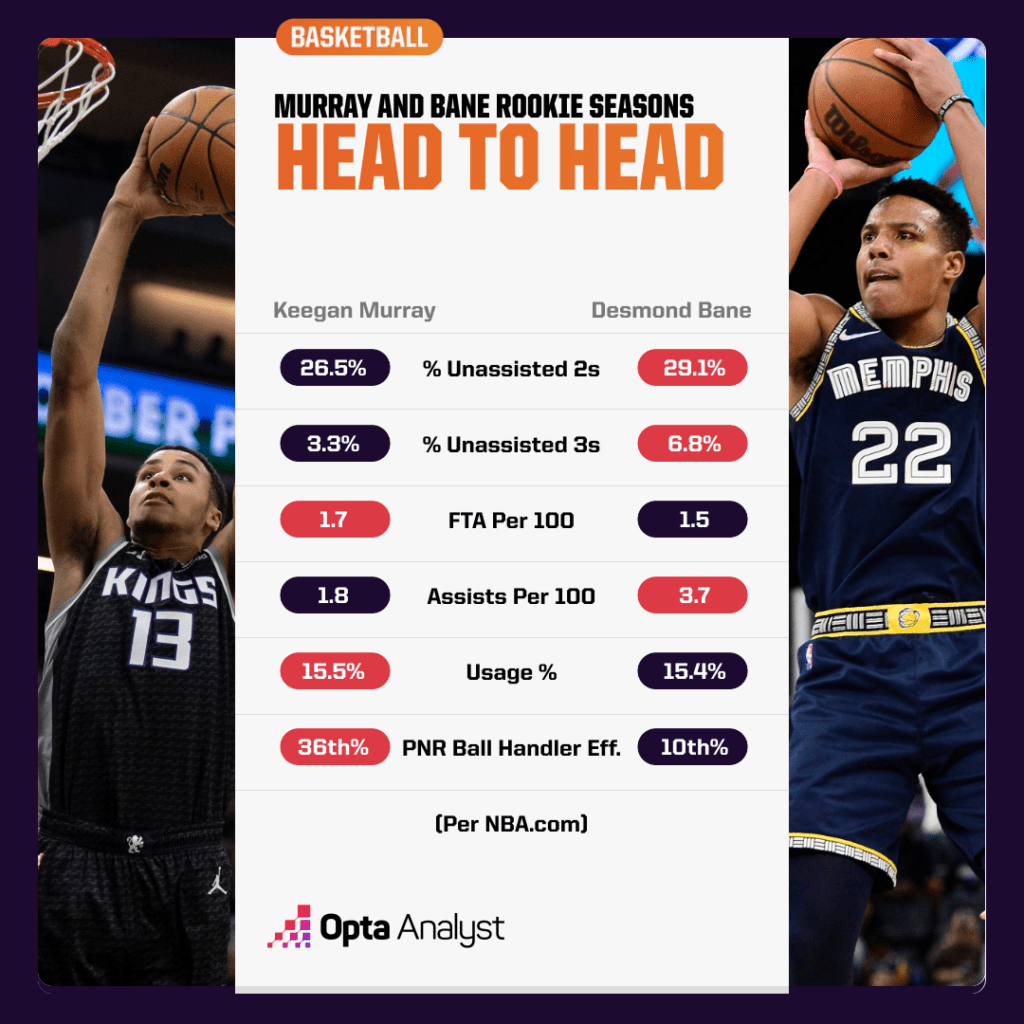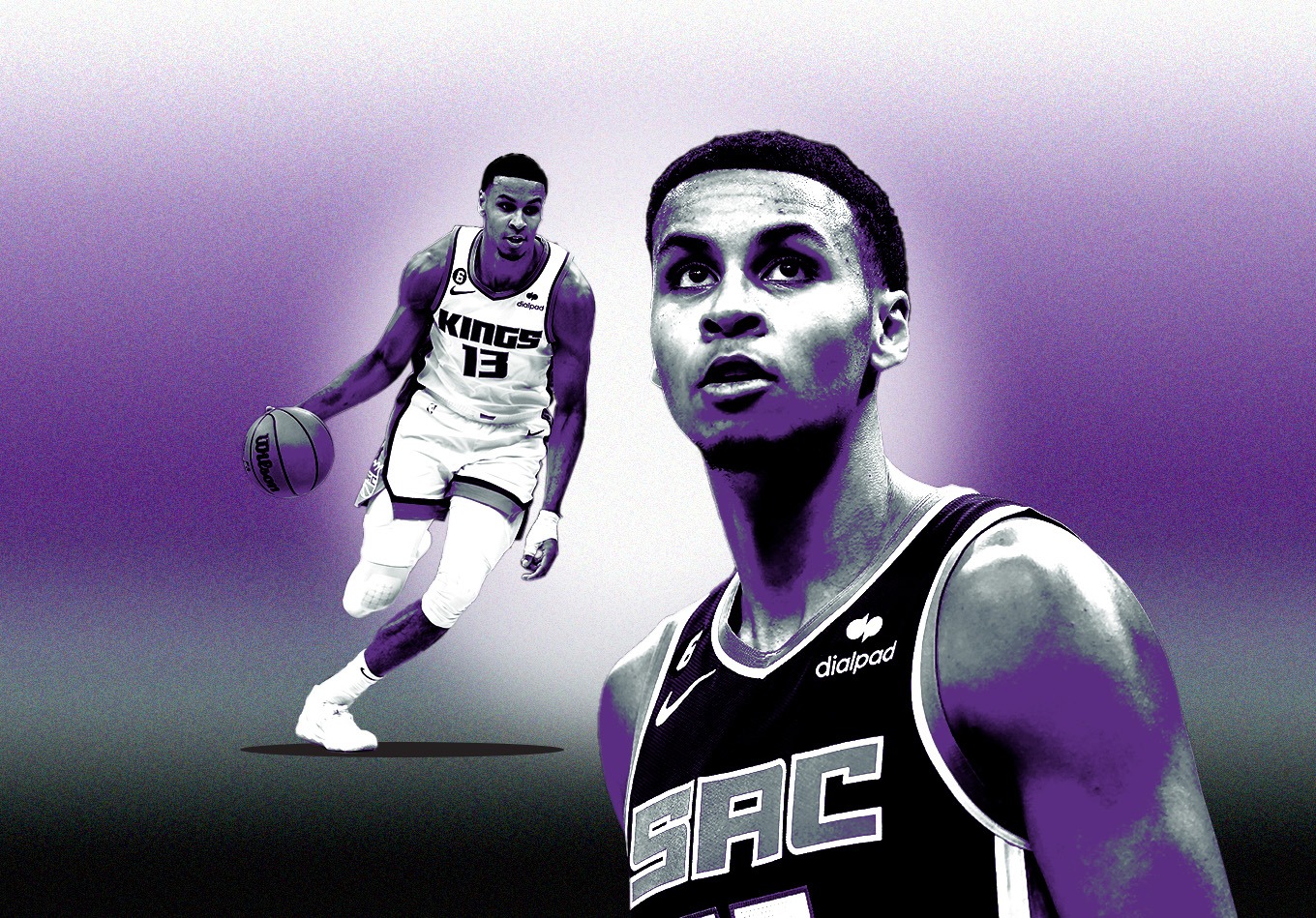When the Sacramento Kings went to bat with the fourth pick in the 2022 NBA Draft, many pundits believed that Jaden Ivey – the fiery speedster whose combination of burst and athleticism garnered comparisons to the likes of Dwayne Wade and Ja Morant – would be their selection.
But alas, as the Kings have historically been known to do, they went against conventional wisdom, opting to use their pick on the less-electric Keegan Murray.
This choice, of course, sparked a great deal of outrage and controversy from fans and analysts alike, including this tweet from Bleacher Report Insider Jonathan Wasserman:
And now that we’ve compiled nearly a season’s worth of data on a team that’s one of the league’s biggest surprises at 38-26, it becomes time to revisit his point: Were the Kings being brilliant or reckless when they used their fourth overall pick to draft Murray?
The Good
A lot of tall rookies come into the league as theoretical shooters, meaning they come out of college with good shooting indicators but struggle early on as they adjust to the speed of the game and increased distance of the 3-point line (see: Jabari Smith Jr.).
At this point, there is nothing theoretical about Murray’s shooting abilities. He’s a legitimate dead-eye marksman, and that’s already been proven beyond a reasonable doubt.
His 40.9% hit rate from downtown is seventh in the league among players hoisting six or more 3s per game, trailing only Stephen Curry, Darius Garland, Buddy Hield, Michael Porter Jr., Desmond Bane, and Bojan Bogdanovic. Holy shooters.
On top of that, his percentage on wide-open 3s (45.9% per NBA.com) is comparable to Bane’s rookie mark (47.3%) – more on why this is meaningful in just a bit.
Murray’s shooting and understanding of space allow him to function as a high-efficiency play-finisher within the Kings’ dynamic motion offense (first in adjusted offensive rating), oftentimes looking like a modern-day Rashard Lewis on that end of the court.
Whether it be via spot-ups (74th percentile in efficiency), handoffs (87th percentile), cuts (53rd percentile), or off-ball screens (69th percentile), Murray is already highly effective at capitalizing on the advantages created by his more ball-dominant teammates. Overall, his 0.7 offensive DRIP is tied with Jalen Williams for the best output among rookies with at least 500 minutes played.
Side note: Murray’s wide base on his jumper may mean that he ultimately ends up being more of a spot-up shooter (ex: Cam Johnson) than a spot-up/movement hybrid (ex: Klay Thompson), which does retract a smidge of his off-ball value.
His understanding of timing and space is also apparent in his team defense. Sacramento may struggle as a whole on that end (25th in adjusted defensive rating), but the team’s issues exist largely outside of Murray, who, to his credit, continues to wow folks with his sound positioning.
- First Clip: The ability to keep one’s head in a constant swivel between their man and the ball is essential to off-ball defense. Murray does this, and as a result, he sniffs out the threat penetrating toward the rim, rotates over, and draws the charge.
- Second Clip: This is largely unspectacular, but it demonstrates his ability to operate in a scramble sequence. First, he tags the rolling Christian Wood, which gives Domantas Sabonis the necessary time to recover. Then, he recovers back to Josh Green on the perimeter, mirroring his drive and forcing a kick out. And finally, he regains himself and identifies the proper offensive player to rotate over to after the chaotic dust clears.
The Bad
This first portion of the section is actually a bit of a red herring, as some scouts worried about Murray’s ability to defend on the perimeter due to his lack of exceptional lateral quickness. However, the early returns on his defense have been quite promising.
He’s got a stiffness about him (as most players with that body type do), and the naysayers are correct in their assessment of his lateral agility. But he’s a confident and willing defender, and his condor length (he’s got a 6-foot-11 wingspan) negates pretty much all the damage done by his lateral shortcomings.
Some may be concerned about how his point-of-attack defense will hold up in the playoffs when teams normally try to target weaker defenders.
And while this is a valid concern, it seems increasingly unlikely that Murray is the King opponents will try to mismatch hunt. A perfect example of this occurred against the Dallas Mavericks in mid-February when Luka Dončić (a mismatch hunter extraordinaire) often opted to go after Kevin Huerter even though Murray was also on the floor.
Believe it or not, the real worry with his game actually comes from his offense. As we said, he’s already an above-average play-finisher. But outside of that, he leaves a lot to be desired.
For starters, great shooters in today’s NBA need to be able to drive closeouts, as teams will usually be doing all that they can to run them off the 3-point line.
Murray struggles in this area. One, because his gangly frame makes it difficult to keep his handle tight while navigating through traffic. And two, as you’ll see in the clips below, he lacks the lower body strength to absorb contact and maintain his balance (however, this problem is not atypical for rookies).
He hardly ever engages in self-generated scoring or playmaking, as less than 8.0% of his shot attempts come after three or more dribbles. And his 1.8 assists per 100 possessions put him in the 26th percentile among rookies with at least 25 games played.
Even though his role is more off-ball centric, his difficulty putting the ball on the floor could present a serious problem in the playoffs, as teams will closeout hard on his 3s and dare him to beat them off-the-dribble (which could lead to him getting benched if he can’t execute in those spots).
The Outlook
We mentioned Bane earlier as a point of comparison and the two have a lot in common when you think about it. Both were 22-year-old rookies, both are extraordinary long-range snipers, both are inhibited to a degree by physical limitations (Murray his lateral speed, Bane his negative wingspan), both are largely effort-based defenders, and both struggled scoring/playmaking off-the-dribble early on.
That’s right, while it is sometimes hard to remember given his significant on-ball offensive growth, Bane also once struggled with creating his own offense. Look at how his rookie numbers compare across the board to Murray’s:

Obviously, the two players play different positions. Bane is a guard, so he doesn’t need to be as impactful of a defender, but Murray makes up for this with his advantage in length.
The point here is that the best version of Murray follows Bane’s offensive trajectory. A player who comes into the league as a high-end play-finisher and then later also develops into a capable secondary offensive creator.
If Murray can manage to do that, while, at the very least, maintaining his standing as an average defender for his position, he becomes the kind of player that consistently dwells in the league’s top 50 during his prime. The kind who, in certain seasons, will warrant All-Star consideration and maybe even receive a nomination or two of his own, depending on the rest of the field.
But even if that doesn’t happen, his combination of off-ball scoring, length, and team defense gives him one of the highest floors in last year’s draft class.
And when you factor that potential in with the massive variability that exists in the inexact science of draft projection, the Kings’ decision to select him over Ivey appears to be a pretty damn good one.
